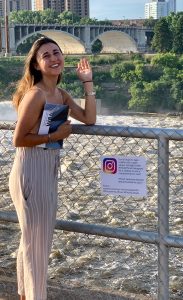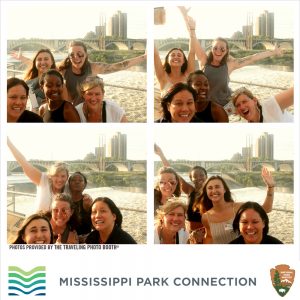Olivia Martinez Museum Education Intern sponsored by the Bronfman Family Internship for the Arts
Students are often the topic of discussion in the breakout sessions at the Association of Academic Museums and Galleries. How can we engage students? How do we bring them into the museum? What programming do we offer? I attended many of the breakout sessions connected to students given my role as a Student Guide at the Colorado Springs Fine Arts Center at Colorado College (FAC Museum), along with my position as Education Intern. I am an undergraduate student studying Education, Southwest Studies, and Spanish. While I started my intern position last August at the beginning of the academic term, I have been a Student Guide in the museum for a year and a half. As someone interested in pursuing museum education, I was excited to be able to partake in this conference experience, particularly since it continued to advocate for student involvement within museums. Attending the conference and thinking about my professional development, my college’s development, and the students’ role in academic museums allowed me to better understand how important students are to the mission of the Education Department at the FAC museum, where visitor engagement is a priority.
 Some of my greatest takeaways involved how I can use my perspective and influence as a student to connect the Fine Arts Center to the student life on campus. One of the most informative sessions I was a part of was “Becoming Part of a Campus Conversation: Bringing Student In”. In this session, panelists discussed ways in which they reach out to students within their own institutions. Academic Museums use Museums Clubs, Advisory Boards, Student-Only Events, After-Hours Events, and partner with different parts of campus to “bring students in”. This session excited me and gave me ideas for how we can better support our students’ talents and organizations on this campus. Working with students and allowing them voice in the conversation regarding engagement and education is the best way to allow these connections between arts and education take place. While I am just one student, my role as Museum Education Intern will allow me to continue the growth of the FAC Museum as it applies to student experiences. The AAMG conference is a great way to exchange ideas, methods, programs and learn about the wide array of people doing important work for their university.
Some of my greatest takeaways involved how I can use my perspective and influence as a student to connect the Fine Arts Center to the student life on campus. One of the most informative sessions I was a part of was “Becoming Part of a Campus Conversation: Bringing Student In”. In this session, panelists discussed ways in which they reach out to students within their own institutions. Academic Museums use Museums Clubs, Advisory Boards, Student-Only Events, After-Hours Events, and partner with different parts of campus to “bring students in”. This session excited me and gave me ideas for how we can better support our students’ talents and organizations on this campus. Working with students and allowing them voice in the conversation regarding engagement and education is the best way to allow these connections between arts and education take place. While I am just one student, my role as Museum Education Intern will allow me to continue the growth of the FAC Museum as it applies to student experiences. The AAMG conference is a great way to exchange ideas, methods, programs and learn about the wide array of people doing important work for their university.
While the sessions were informative and thought provoking, the city of Minneapolis also provided us with other ways to learn about engagement on different scales. We visited the Fredrick R. Weisman Art Museum on the University of Minnesota campus. There, I was able to explore how other academic museums function in a historic setting as the museum resided in the famous Frank Gehry building. After exploring this museum, we crossed the flowing Mississippi River to the Mill City Museum situated in the old Gold Medal Flour Mill. The museum included interactives related to the sugary and yummy cereal of General Mills and other brands, along with the education spaces and tactile interactives. The Mill Museum featured a 4D Experience called the “Flour Tower” which was an engaging way to take visitors through the history of the mill. It was interesting to see how museums use different tools and methods to interact with visitors, and I considered ways we could integrate engaging learning opportunities within our own museum. I also found that preserving the building itself to tell the history of the area was an interesting method of engagement. I was able to imagine the mill at working capacity and explore its ruins at the same time.
After a compelling view from the ninth floor of the mill, we ventured just outside to the river banks where we came across a National Parks Service (NPS) event. The lock of the dam had been previously closed to the public, but after the NPS opened it to the public, they have been working on ways to use the space and have people visit the lock. They set up photo stations outside encouraging visitors to take their different challenges for their photo experience. We experimented with some of their challenges, and you can see how much fun we had in our expressions in this souvenir we were able to take  with us. This made me think more personally how not just museums, but many organizations and non-profits are trying to engage and educate visitors. Education is powerful and can take place in a variety of ways and seeing these various forms of informal education made me reconceptualize my role in our dynamic museum space.
with us. This made me think more personally how not just museums, but many organizations and non-profits are trying to engage and educate visitors. Education is powerful and can take place in a variety of ways and seeing these various forms of informal education made me reconceptualize my role in our dynamic museum space.
Overall, experience at the AAMG and in Minneapolis inspired me. It made me think critically about how we function at the FAC Museum, the ways we can get students, faculty, course, and other campus organizations into the FAC Museum. We want the student body to see the museum as a resource in their life and their learning, so we have to be intentional in our connections. The AAMG conference and related experiences exposed me to the various ways to further engage the FAC Museum mission.

